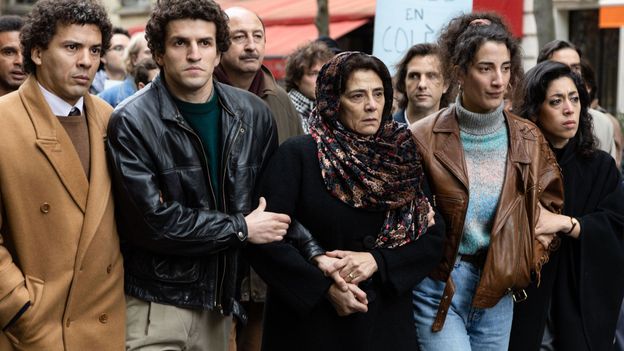Oussekine tells the story of Oussekine’s death from the perspective of the oppressed – not just Oussekine himself but his family, as they fought for justice. It was created, written and directed by Antoine Chevrollier (previously one of the directors of the spy thriller series Le Bureau, starring Kassovitz) and co-written by French literary sensation Faïza Guène, as well as Julien Lilti and Cédric Ido, with the writer representative piece of multicultural France represented on screen. Talent in front of the camera includes Hiam Abbas, the revered Palestinian actress perhaps better known as Marcia Roy in Succession, who plays Oussekine’s mother, in what is another incredible performance, alongside rising stars Sayyid El Alami, Malek Lamraoui, Tewfik Jallab, Naidra Ayadi and Mouna Soualem.
The creator of the Chevrollier series was around 10 years old when he first encountered the tragic story of Oussekine. Too young to watch La Haine, he heard the name on a rap album inspired by the film. “It was a song by the group Assassin called L’état Assassin, and the chorus was “L’état Assassin, une exemple Malik Oussekine” [The state of the assassin/one example Malik Oussekine]and his name is etched in my memory.”
In March, the first episode of Oussekine played on the closing night of the French television festival Series Mania in Lille, where the public was spellbound. The opening traces how news of Malik’s death filtered down to the rest of the family. Rather than showing the moment of death, it focuses on the anguish that Malik’s sister, Sarah, goes through as she assesses how and when she will tell his mother that her son is dead.
In an effort to provide multiple perspectives on Malik’s life and death, the four episodes are divided thematically. The second focuses on the police cover-up as they first lie about when and how Malik died, then try to massage testimonies and reports to put themselves in the best possible light. The third delves into Oussekine’s family history, with flashbacks to their life in Algeria from 1977, as it traces how Malik’s parents made the decision to move to France. The final episode revolves around the court case, asking philosophical questions about the treatment of immigrants and what it means to be a multicultural society.
A national awakening
“There was a period of hope for many immigrants, especially North Africans, following the election of President Mitterrand [in 1981]says Chevrollier. In 1984, the socialist government of Mitterrand carried out a major reform which strengthened the rights of immigrants by introducing a combined residence and work permit for foreign residents valid for up to 10 years. This is part of a philosophy that gained momentum after the 1968 Paris protest that the idea of a single, monolithic French culture was outdated in a world where people moved faster: “But death of Oussekine was the beginning of a less rosy reality”, explains Chevrollier.

